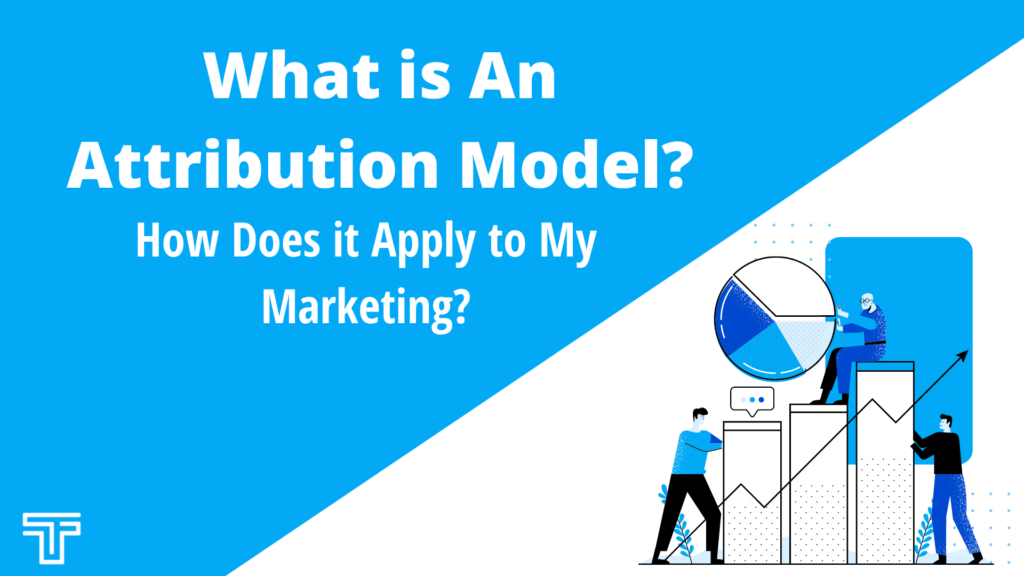What is an Attribution Model?
Attribution modeling is a framework for analyzing which touchpoints, or marketing channels, receive credit for a conversion. Each attribution model distributes the value of a conversion across each touchpoint differently.
The easiest way to explain an attribution model is to look at a scenario of touch points.

- Jim Jones sees a Google Ad about company X, clicks it and visits the website but doesn’t convert yet
- Jim Jones sees a social media post shared from one of his network connections a week later and decides to visit company X’s LinkedIn page. He then follows it after seeing an interesting visual pinned at the top
- 1 month later Jim Jones see a value trade off from Company X where he downloads a template in exchange for his email
- 3 months after receiving consistent emails he sees a promotional offer that fits perfectly for him and reaches out to a representative
So the attribution model aims to identify which touchpoint converted Jim Jones as well as which others played a role in nurturing. In this scenario it would have been a consistent email marketing campaign that included a specific offer that finally converted him.
A True Attribution Model is Impossible
Sadly figuring out your business’ true attribution model is actually impossible. There are ways to get as close as possible, but the restrictions on tracking only allow us to do so much. You can often identify when someone first engages and when they finally convert but the middle is challenging to track. If someone approaches you and tells you that they can identify the entirety of your attribution model then they are likely lying. This is because there are regulations and laws that protect consumer information.
You’ll see this a lot in Google Analytics when a set of data says “not set”. This means that Google Analytics couldn’t take the data because the consumer has some sort of protection software. This gets taken even further when we attempt to track a user across multiple platforms. We will likely see more regulations and laws introduced in the future which would further limit our ability to gather this type of information.
Ultimately, there’s no way for a company to track a single person throughout the entire process without manual intervention. Using the same scenario from above Company x has no way of knowing that it was Jim Jones that clicked on the google ads, then clicked on the social media post that his network shared and so on. All the company knows is that it was the email that got sent that made him convert (assuming you have tracking for email).
What Can We Do To Get Close To An Attribution Model
Although it’s impossible to get a true marketing attribution model we can try to get as close as possible. We do this by applying the marketing funnel and the different marketing initiatives that push customers through it. By breaking it down like this we can select which objective and marketing activities are providing the best performance per associated area.
Let’s go through a scenario where we focus on each stage of the marketing funnel.
Awareness Stage
Bee’s Coffee has identified that Influencer marketing is great for getting the word out but not good when it comes to pushing for sales. Because of this they have made the conscious choice to keep their influencer marketing efforts focused on awareness and website traffic.
Consideration
For the consideration stage Bee’s coffee has conducted two different marketing activities. The first is hosting live chats with coffee experts on a monthly basis and the second activity is circulating infographics on their social media about why their coffee is better than their competitors. Through this they determined that the infographic has gotten more people to their website than the live chats. So they decided to put their efforts into creating more creative visuals.
Decision
The type of marketing activities that Bee’s coffee conducts in the decision stage are free samples of their most popular coffee and a list of customer reviews on their website. They find that the free sample of their most popular coffee blend is a huge hit and makes people come back to purchase the full size bag. The reviews / customer oriented focus on the website lead to people wanting to check out the in-store atmosphere, which is a common topic in the customer reviews.
Multi-stage marketing activities
Bee’s coffee figured out that Google Ads was useful for awareness, consideration and the decision phase. They have now selected to run Google Display Ads as an awareness campaign, Google Remarketing Ads for the consideration stage and Google Maps ads for spontaneous visits. Their budget per campaign changes as they need to stimulate certain areas of the funnel.
So as you can see Bee’s Coffee was able to determine which marketing activities achieved their goals according to each stage. They still can’t say which pieces got a new customer to actually visit and purchase but they can hone in on each section for optimal performance.
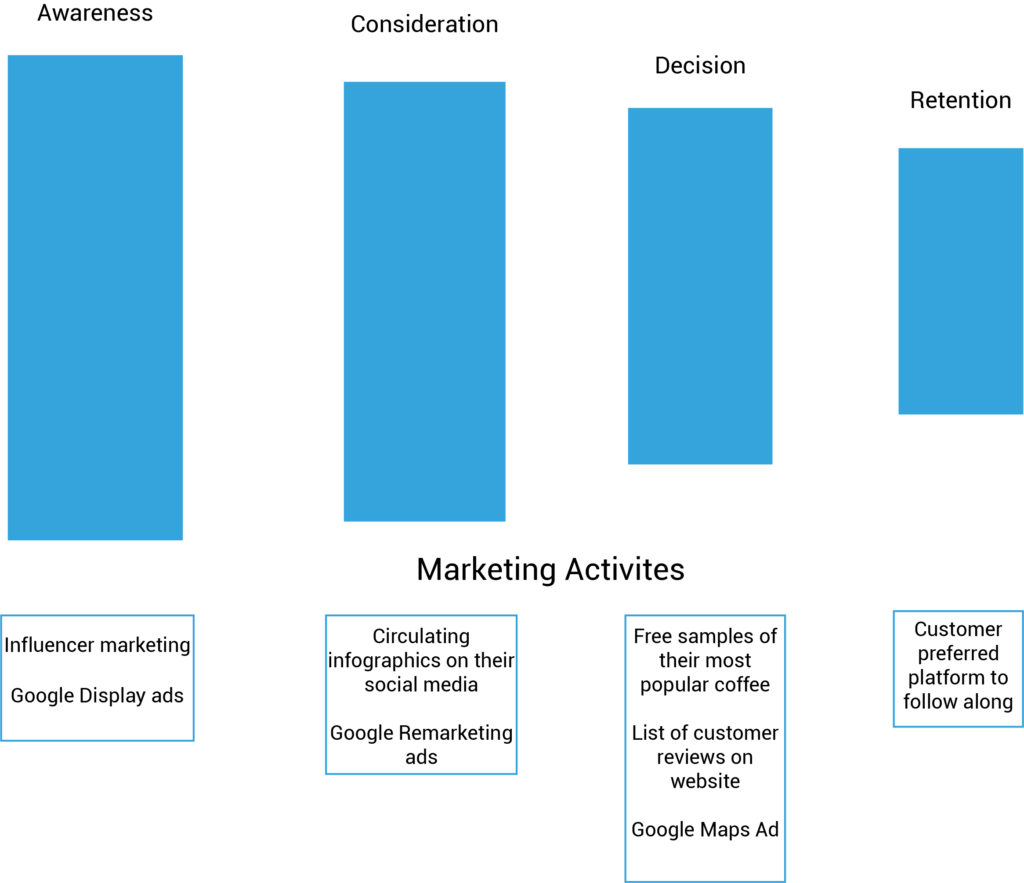
Complex Versions of an Attribution Model:
Although the application of an attribution model is difficult there is value in understanding it and what it might look like for your customer journey. Here are a few complex versions of an attribution model.
Single Touch
First Touch Attribution Model
The first-touch attribution model gives credit to the first touch point, regardless of whether a marketing campaign directly influenced the sale or not.
For example, you see a Facebook ad for a piece of content, you’re immediately interested and click on the ad and read through the page. You then decide you want to download the resource so you enter your information. A few days later the same company emails you with another product that you also want to have. You talk to their team and purchase the product.
Using the first-click attribution model the original facebook ad gets the credit for the new customer. Although the customer might see and click from marketing campaign to marketing campaign, the first click is the most important.
This attribution model is useful when you’re trying to discover the methods that drive the most new customers. Once you determine what that is you can increase your resources into that channel.
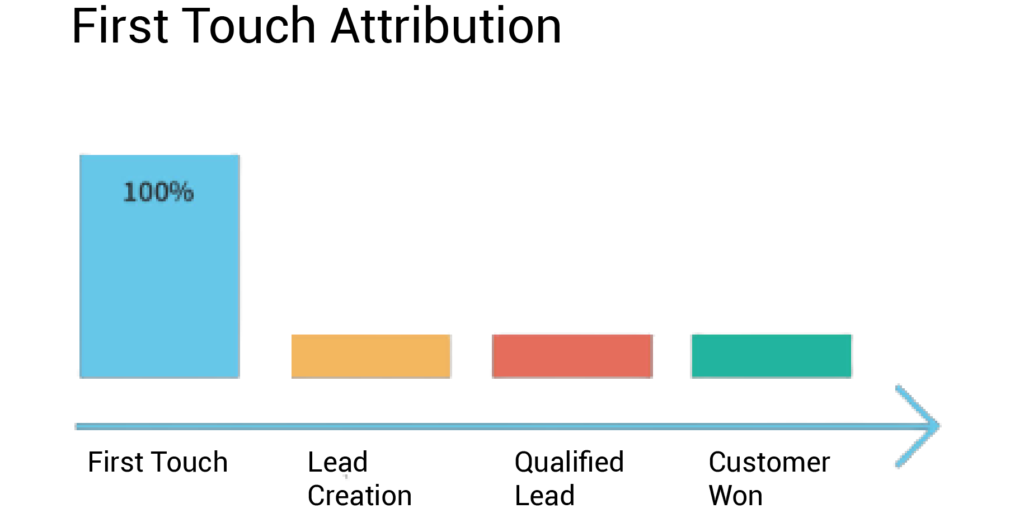
Last Touch Attribution Model
Conversely, the last-touch attribution model gives full credit to the last touchpoint the customer interacted with before making a purchase.
You’re scrolling through Facebook, you see an ad, click on it, read through the page and then leave. Few days go by and you decide that you’re actually interested in the product so you type the company’s url, go to their pricing page, pick your product and purchase.
In this case the direct traffic (or SEO) gets all of the credit for the purchase.
This attribution model is most effective when you want to find out which channels are providing the most conversion. Is it the email with a discount code that you sent? Is it your landing page? Once you figure it out you can put more effort into leveraging those channels to get more conversions.
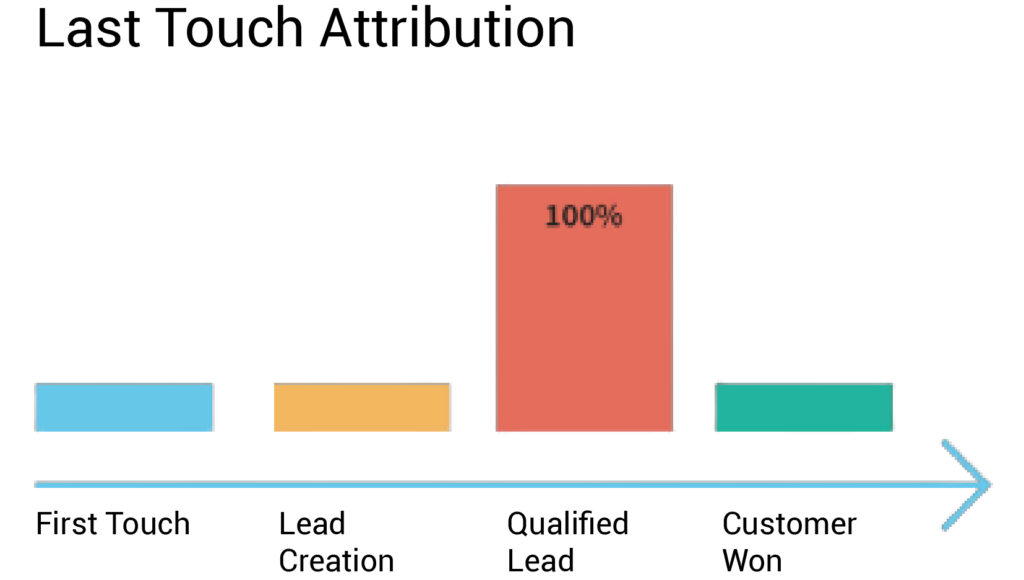
Last Non Direct Click Attribution Model
The last non direct click attribution model gives conversion credit to the place that people clicked last. The key difference between the last-touch model and the last non direct click attribution model is that the last non direct click gives credit to the last source that wasn’t direct traffic.
For example, you see a Facebook ad, click on it but don’t convert. Later one you type in the website URL, browse the website and purchase a product.
In this model the Facebook ad would receive the credit for the conversion. This model can be used when you want to measure marketing success excluding direct traffic. It might not do you any good to measure loads of traffic coming to your website if you don’t know the initial marketing trigger behind that traffic.
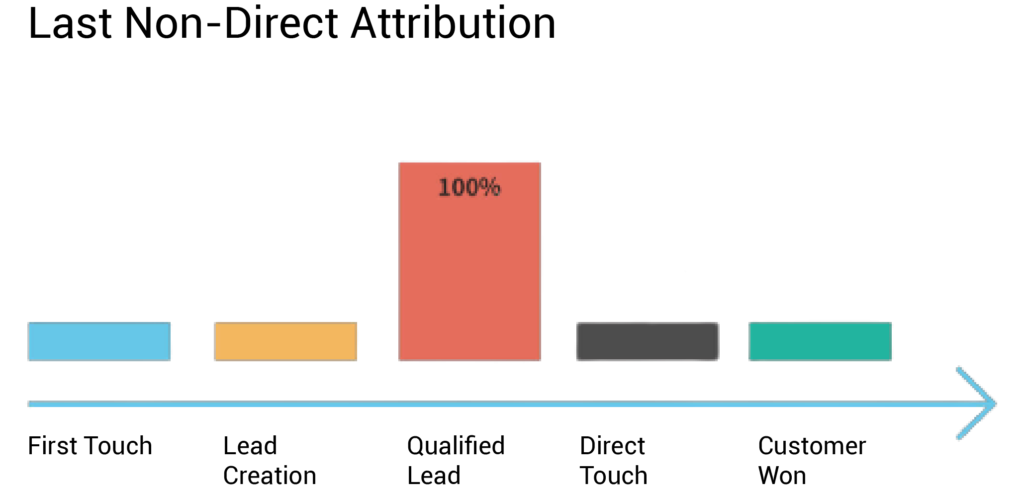
Multi-touch
Linear Attribution Model
This model gives equal credit to all of your channels and all the channels the customer visits before purchasing.
A customer finds you on Instagram, signs up for your email list and later clicks an email link. The next week they go to your website and make a purchase.
In this case the Instagram ad, email sign up and email link all get equal credit for the conversion. This attribution model usually gives you a more balanced look at your entire marking strategy rather than a single point. After a while you’ll start to see certain channels pull in more conversion than others. You can then focus your attention on those channels. But as we mentioned above this can be difficult to track unless there is a unique identifier we can carry over from touch point to touch point.
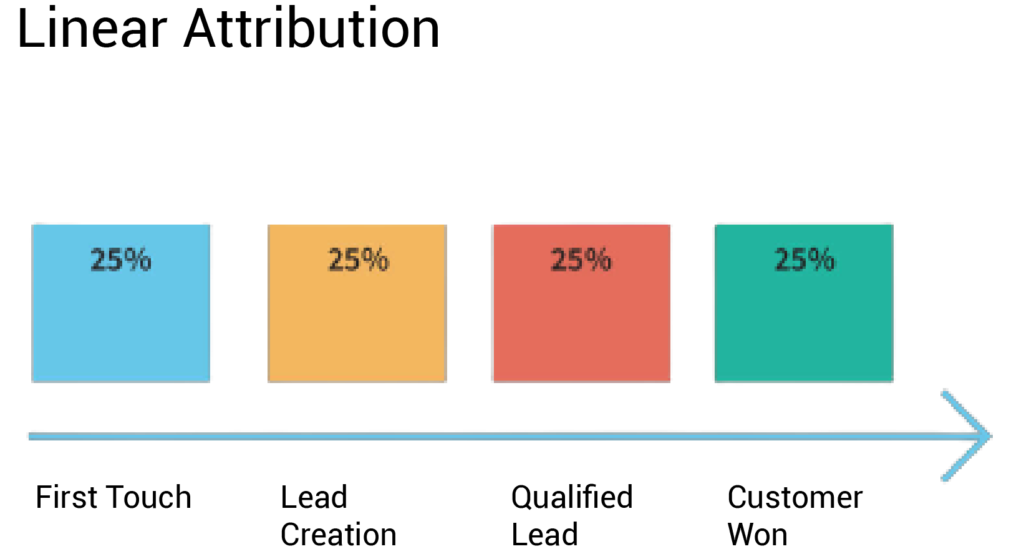
Position Based Attribution Model
This model (also called u-shaped) splits the credit for a sale between the first touch and the last touch. The first and last touch both receive 40% and everything in between receives the remaining 20%.
Someone finds you through a google search, looks at your facebook page and then later signs up for your email newsletter.
The Google search and the email newsletter would receive 40% of the credit and the Facebook visit would receive the remaining 20%. This makes sense as it’s the first touch point that acquired the new customer and the last touch point that converted them. So this model will help you determine which channels are best for acquiring and which are best for converting.
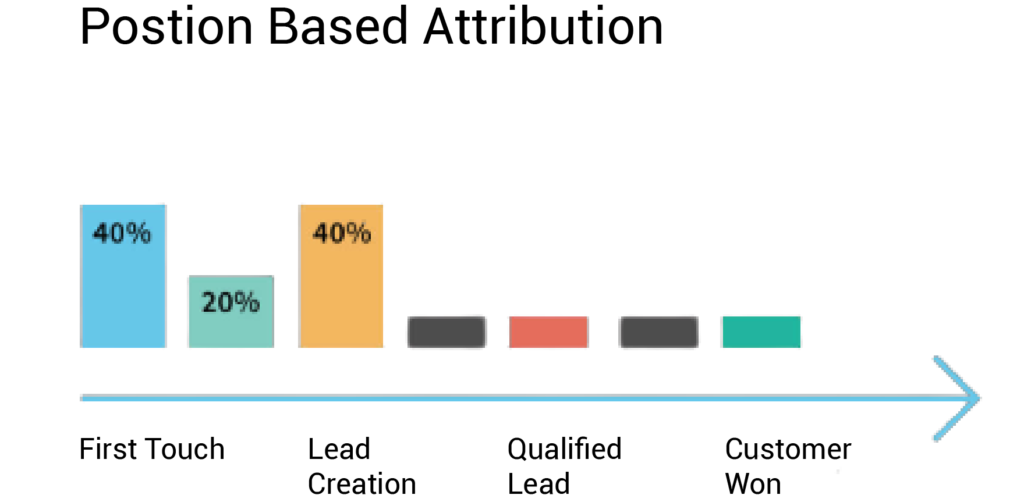
Time-Decay Attribution Model
Similar to the linear model, the time-decay model spreads the value out across multiple events. However, the model also takes into consideration when each touchpoint occurred. Interactions that occur closer to the time of purchase receive more credit than the first interactions.
For example, a customer sees a display ad then goes to an email then to a Facebook ad then types the website URL then finds your website again through the search engine.
The organic search would have the most credit, then the direct search, then the facebook ad, then the email and finally the display ad. You can use this attribution model to effectively determine which channels drive conversion and which channels are more awareness generation, traffic generating channels.
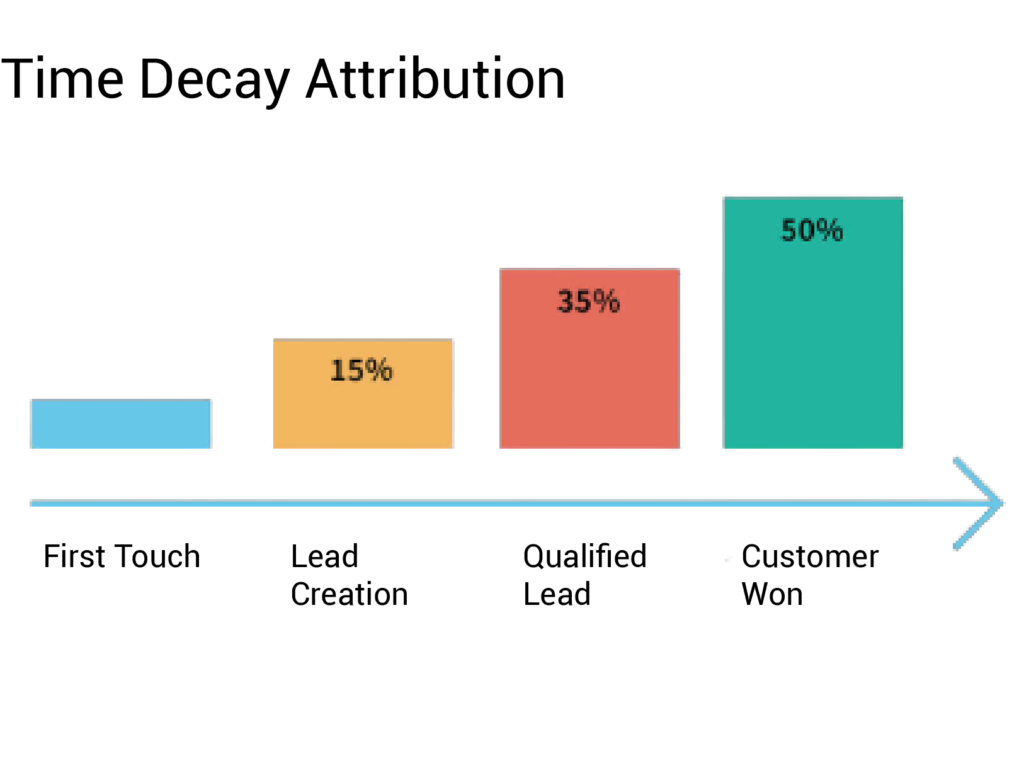
Where to Find Attribution Model Reports in Google Analytics
Google Analytics by default uses last touch attribution model but you can compare different attribution models in your account.
To find this tool go to:
Conversions > multi-channel funnels > Model Comparison Tool.
You can also see how long it took people to convert by going to
Multi-channel funnels > time Lag
And how many sessions it took people to convert by going to
Multi-channel funnels > path length
This might be a good starting point if you’re still not sure which attribution model is best for your business. You can take a look through the data that Google Analytics provides for you
Here’s an example of a Google Analytics report
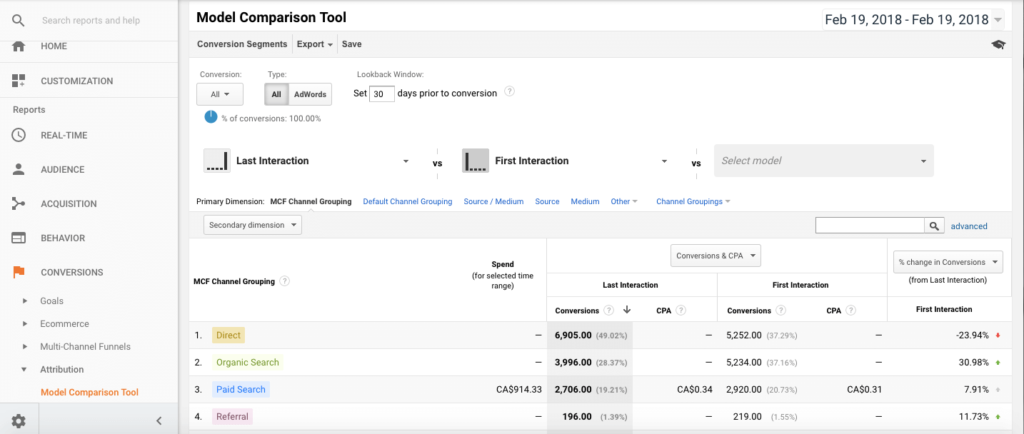
Recommended Process To Understand, Track and Implement Based on an Attribution Model
So we’ve gone through some different attribution models but how do you actually put it into practice? There is no perfect model and most likely you will have to use a combination of models in order to get some semblance of the true attribution model.
- Select which attribution model best suits your sales cycle.
- Depending on if you sell products or services, are B2B or B2C your sales cycle will differ and different attribution models will work for you.
- Track it for a few months
- You’ll want to use that attribution model and see if it provides you with valuable information. If it doesn’t then try another one.
- Make changes based on your findings
- If you found that Facebook is a great channel for conversion, great! You can now put more effort into that channel to get more conversions. If you still haven’t figured it out that’s ok too. Try another channel and evaluate.
In the end there is no right answer and all you can do is try your best to get as close to your attribution model as possible.
